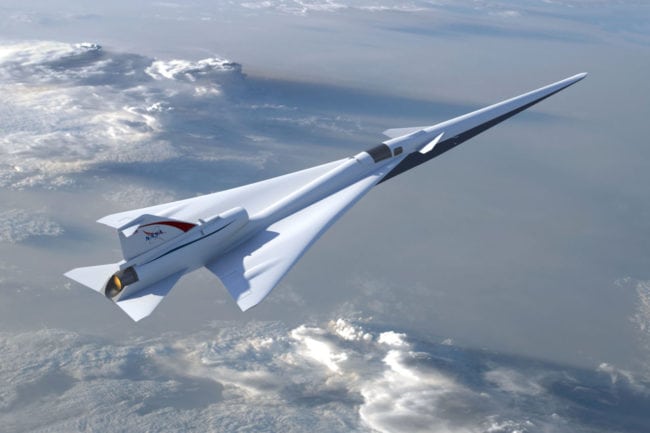
Illustration of NASA’s X-59 Quesst low-boom demonstration aircraft. (NASA/Lockheed Martin)
A panel of aviation industry experts discussed cutting-edge technologies and where the industry needs to evolve at the Air Traffic Control Association’s annual Blue Skies event on Thursday. On the menu were super- and hypersonics, AI and gaming technology.
“We have to recognize ‘next-gen’ as history,” said Aireon CTO Vincent Capezzuto, setting the tone for the forward-focused panel.
Robert Pearce, NASA’s deputy associate administrator for strategy, said that the agency is involved in both supersonic and hypersonic technology research. The former is much more immediately relevant to the commercial space, though.
“Hypersonics, for commercial applications, we’re still a couple decades away,” Pearce said. “The military is weaponizing that technology…. NASA will work with the DOD, and we’ll use the flight opportunities that are coming to better our understanding of that environment and the fundamentals to build those kinds of vehicles, but you just can’t—for hypersonics, you just don’t have the margins yet” to make commercial hypersonic vehicles viable.
Supersonics, however, he said are very relevant in the commercial space. The rules governing their use dictate that they can only be used over water, not land, primarily because the sonic boom they create can be a disturbance or possibly destructive. However, supersonic vehicles have come back into vogue because Pearce said engineers such as those at NASA are “seeing if we can soften the boom so it’s acceptable of a level to fly over land. Finding ways to shape an aircraft so the shockwaves won’t coalesce to create the pressure differentials that create those shockwaves.”
NASA believes it has done that up to Mach 1.4 and perhaps Mach 1.8, according to Pearce, with its experimental supersonic X-59 plane. Faster than that and it gets too hard to contain the noise, but that still entails more than doubling the typical speed of current commercial travel. There will be a first flight in 2021 and further trials out to 2023; Pearce said the hope is that, if NASA can show via noise sensors on the ground and local residents that the noise has been kept to an acceptable level, the rule can be changed to allow supersonic flight over land.
If that does happen, air traffic control infrastructure would need to be adapted to account for the additional traffic flying at a different altitude and speed and needing to be integrated back in close to airports, but he said that increased automation could take on the brunt of the additional complexity.
Another hot-button technology the panel discussed is artificial intelligence, but here again they cautioned patience. Microsoft’s Jim Piavis, who is a principal program manager focused on the research of technologies such as AI and drones for the company, noted that people overestimate how far along AI technology is.
He said that while machines can learn and act, “we’re so far from them really being intelligent,” and that Microsoft has trouble getting machines to think and learn on the level of a two-year-old. He pointed to the chat-bot Tay that Microsoft unleashed on Twitter in 2016 and turned racist and profane in less than a day for an example of the company not being fully on top of machine learning yet.
Piavis did note that Amazon’s Alexa “does pretty well,” but is still not without obvious fault, often failing to answer simple questions.
Piavis said, though, that while training machines to do something such as drive a car has proven tricky for Uber and Tesla, it could actually be considerably easier for the urban air mobility industry. The roadways, he said, are incredibly complex, and there are fewer variables to account for in the sky—it is less likely, for instance, that wildlife runs out in front of your vehicle.
Something more mature, Piavis said, is the implementation of gaming technology in aviation. It can be used to help train AI but is equally useful for training human pilots—particularly members of the younger generations, who can start learning earlier.
“People can learn on sims,” Piavis said. “But you apply scoring and it’s amazing how long a kid will sit and play that one landing on a simple (Cessna) 172 because he can increase his score; but what he’s doing is improving his skill set, so when he transfers to the real world, he’s not taking as much time learning the hardware.”